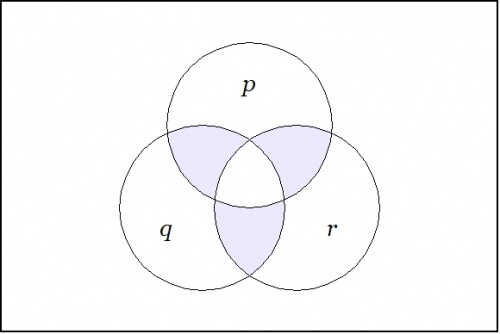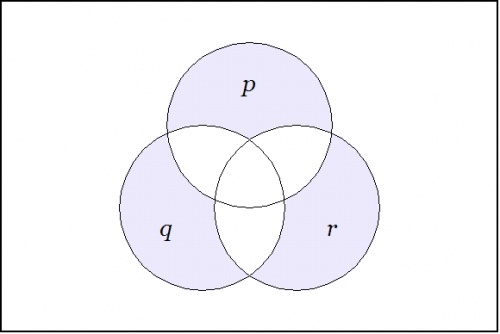Difference between revisions of "Minimal negation operator"
Jon Awbrey (talk | contribs) (→Truth tables: redo table) |
Jon Awbrey (talk | contribs) (revise typographical conventions) |
||
| Line 1: | Line 1: | ||
| − | + | The '''minimal negation operator''' <math>\nu\!</math> is a [[multigrade operator]] <math>(\nu_k)_{k \in \mathbb{N}}</math> where each <math>\nu_k\!</math> is a <math>k\!</math>-ary [[boolean function]] defined in such a way that <math>\nu_k (x_1, \ldots , x_k) = 1</math> if and only if exactly one of the arguments <math>x_j\!</math> is <math>0.\!</math> | |
| − | In contexts where the initial letter <math>\nu\!</math> is understood, the minimal negation operators | + | In contexts where the initial letter <math>\nu\!</math> is understood, the minimal negation operators may be indicated by argument lists in parentheses. In the following text, a distinctive typeface will be used for logical expressions based on minimal negation operators, for example, <math>\texttt{(x, y, z)}</math> = <math>\nu (x, y, z).\!</math> |
| + | |||
| + | The first four members of this family of operators are shown below, with paraphrases in a couple of other notations, where tildes and primes, respectively, indicate logical negation | ||
{| align="center" cellpadding="10" style="text-align:center" | {| align="center" cellpadding="10" style="text-align:center" | ||
| Line 10: | Line 12: | ||
& = & \operatorname{false} | & = & \operatorname{false} | ||
\\[6pt] | \\[6pt] | ||
| − | \texttt{( | + | \texttt{(x)} |
| − | & = & | + | & = & \tilde{x} |
| − | \tilde{x} | ||
& = & x^\prime | & = & x^\prime | ||
\\[6pt] | \\[6pt] | ||
| − | \texttt{( | + | \texttt{(x, y)} |
| − | & = & | + | & = & \tilde{x}y \lor x\tilde{y} |
| − | \tilde{x}y \lor x\tilde{y} | + | & = & x^\prime y \lor x y^\prime |
| − | & = & | ||
| − | x^\prime y \lor x y^\prime | ||
\\[6pt] | \\[6pt] | ||
| − | \texttt{( | + | \texttt{(x, y, z)} |
| − | & = & | + | & = & \tilde{x}yz \lor x\tilde{y}z \lor xy\tilde{z} |
| − | \tilde{x}yz \lor x\tilde{y}z \lor xy\tilde{z} | + | & = & x^\prime y z \lor x y^\prime z \lor x y z^\prime |
| − | & = & | ||
| − | x^\prime y z \lor x y^\prime z \lor x y z^\prime | ||
\end{matrix}</math> | \end{matrix}</math> | ||
|} | |} | ||
| − | It may also be noted that <math>\texttt{( | + | It may also be noted that <math>\texttt{(x, y)}</math> is the same function as <math>x + y\!</math> and <math>x \ne y</math>, and that the inclusive disjunctions indicated for <math>\texttt{(x, y)}</math> and for <math>\texttt{(x, y, z)}</math> may be replaced with exclusive disjunctions without affecting the meaning, because the terms disjoined are already disjoint. However, the function <math>\texttt{(x, y, z)}</math> is not the same thing as the function <math>x + y + z\!</math>. |
The minimal negation operator ('''mno''') has a legion of aliases: ''logical boundary operator'', ''[[limen|limen operator]]'', ''threshold operator'', or ''least action operator'', to name but a few. The rationale for these names is visible in the [[venn diagram]]s of the corresponding operations on [[set]]s. | The minimal negation operator ('''mno''') has a legion of aliases: ''logical boundary operator'', ''[[limen|limen operator]]'', ''threshold operator'', or ''least action operator'', to name but a few. The rationale for these names is visible in the [[venn diagram]]s of the corresponding operations on [[set]]s. | ||
| Line 229: | Line 226: | ||
To pass from these limiting examples to the general case, observe that a singular proposition <math>s : \mathbb{B}^k \to \mathbb{B}</math> can be given canonical expression as a conjunction of literals, <math>s = e_1 e_2 \ldots e_{k-1} e_k</math>. Then the proposition <math>\nu (e_1, e_2, \ldots, e_{k-1}, e_k)</math> is <math>1\!</math> on the points adjacent to the point where <math>s\!</math> is <math>1,\!</math> and 0 everywhere else on the cube. | To pass from these limiting examples to the general case, observe that a singular proposition <math>s : \mathbb{B}^k \to \mathbb{B}</math> can be given canonical expression as a conjunction of literals, <math>s = e_1 e_2 \ldots e_{k-1} e_k</math>. Then the proposition <math>\nu (e_1, e_2, \ldots, e_{k-1}, e_k)</math> is <math>1\!</math> on the points adjacent to the point where <math>s\!</math> is <math>1,\!</math> and 0 everywhere else on the cube. | ||
| − | For example, consider the case where <math>k = 3.\!</math> Then the minimal negation operation <math>\nu (p, q, r)\!</math> — written more simply as <math>\texttt{( | + | For example, consider the case where <math>k = 3.\!</math> Then the minimal negation operation <math>\nu (p, q, r)\!</math> — written more simply as <math>\texttt{(p, q, r)}</math> — has the following venn diagram: |
{| align="center" cellpadding="10" style="text-align:center" | {| align="center" cellpadding="10" style="text-align:center" | ||
| | | | ||
<p>[[Image:Venn Diagram (P,Q,R).jpg|500px]]</p> | <p>[[Image:Venn Diagram (P,Q,R).jpg|500px]]</p> | ||
| − | <p><math>\text{Figure 2.} ~~ \texttt{( | + | <p><math>\text{Figure 2.}~~\texttt{(p, q, r)}</math> |
|} | |} | ||
| − | For a contrasting example, the boolean function expressed by the form <math>\texttt{(( | + | For a contrasting example, the boolean function expressed by the form <math>\texttt{((p),(q),(r))}</math> has the following venn diagram: |
{| align="center" cellpadding="10" style="text-align:center" | {| align="center" cellpadding="10" style="text-align:center" | ||
| | | | ||
<p>[[Image:Venn Diagram ((P),(Q),(R)).jpg|500px]]</p> | <p>[[Image:Venn Diagram ((P),(Q),(R)).jpg|500px]]</p> | ||
| − | <p><math>\text{Figure 3.} ~~ \texttt{(( | + | <p><math>\text{Figure 3.}~~\texttt{((p),(q),(r))}</math> |
|} | |} | ||
Revision as of 17:18, 23 August 2009
The minimal negation operator \(\nu\!\) is a multigrade operator \((\nu_k)_{k \in \mathbb{N}}\) where each \(\nu_k\!\) is a \(k\!\)-ary boolean function defined in such a way that \(\nu_k (x_1, \ldots , x_k) = 1\) if and only if exactly one of the arguments \(x_j\!\) is \(0.\!\)
In contexts where the initial letter \(\nu\!\) is understood, the minimal negation operators may be indicated by argument lists in parentheses. In the following text, a distinctive typeface will be used for logical expressions based on minimal negation operators, for example, \(\texttt{(x, y, z)}\) = \(\nu (x, y, z).\!\)
The first four members of this family of operators are shown below, with paraphrases in a couple of other notations, where tildes and primes, respectively, indicate logical negation
|
\(\begin{matrix} \texttt{(~)} & = & 0 & = & \operatorname{false} \'"`UNIQ-MathJax1-QINU`"' * The point \((0, 0, \ldots , 0, 0)\) with all 0's as coordinates is the point where the conjunction of all negated variables evaluates to \(1,\!\) namely, the point where:
To pass from these limiting examples to the general case, observe that a singular proposition \(s : \mathbb{B}^k \to \mathbb{B}\) can be given canonical expression as a conjunction of literals, \(s = e_1 e_2 \ldots e_{k-1} e_k\). Then the proposition \(\nu (e_1, e_2, \ldots, e_{k-1}, e_k)\) is \(1\!\) on the points adjacent to the point where \(s\!\) is \(1,\!\) and 0 everywhere else on the cube. For example, consider the case where \(k = 3.\!\) Then the minimal negation operation \(\nu (p, q, r)\!\) — written more simply as \(\texttt{(p, q, r)}\) — has the following venn diagram:
For a contrasting example, the boolean function expressed by the form \(\texttt{((p),(q),(r))}\) has the following venn diagram:
Glossary of basic terms
See alsoTemplate:Col-break
External links
|

